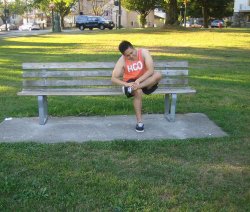An ankle sprain is the tearing of the ligaments of the ankle. It usually happens on the lateral or outside area of the ankle. One or more ligaments on the outer side of the ankle are torn or stretched. Usually the ankle is rolled inward or inversion sprain or outward or the eversion sprain. An inversion sprain which is the common type causes pain on the outer area of the ankle.
Symptoms of ankle sprain
- Pain after twisting an ankle due to inversion injury where the foot rolls under the ankle or leg.
- Severe swelling and bleeding under the skin or bruising
- Incapable of putting weight on the affected foot.
Degrees of severity
1st degree
- There is stretching and mild tearing of the ligament but the joint can still bear weight.
- There will be swelling, mild pain and swelling of the affected area.
2nd degree

- Severe tearing of the ligaments
- Moderate instability of the joint
- Bearing weight on the affected foot becomes painful
- Swelling and stiffness of the area
3rd degree
- Total rupture of the ligaments and loss of motion
- Total instability of the joint with a loss function of the joint
- Severe pain and swelling
Treatment
- Get plenty of rest especially the affected ankle. Stop performing activities that cause limping or pain.
- Use crutches when walking to prevent further injury and worsen the condition.
- Apply an ice pack on the affected area to lessen inflammation and prevent bleeding if there is a torn ligament. Avoid applying ice directly on the skin to prevent frostbite and worsen the condition. Place ice in a plastic bag and wrap it in a towel and place it on the area for at least 15 to 20 minutes, three to five times every day on the first three days. Another alternative fill a tub with ice water and soak the affected foot and ankle. Avoid applying ice if suffering from diabetes.
- Compress the ankle joint using an elastic bandage by wrapping the toes until the mid-calf. Keep the bandage on until swelling subsides. Avoid wrapping it too tight to prevent stopping of blood circulation in the area. Loosen wraps if the toes become blue, cold and numb.
- Elevate the affected area above the level of the heart to prevent accumulation of fluid from the area.
- Take prescribed over-the-counter pain medications such as acetaminophen or ibuprofen to lessen inflammation and pain.
- Start performing rehabilitation exercises with the help of the physical therapist.
Tips
- Warm up by taking a leisurely walk to condition the joint of the ankle before playing a sport or performing exercises. Wear a brace while performing exercises for stability of the joint of the ankle.
- Wear appropriate shoes or fit properly and comfortable to stabilize the ankle while exercising.
- Avoid wearing high heeled shoes.